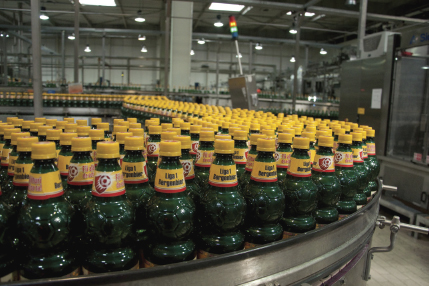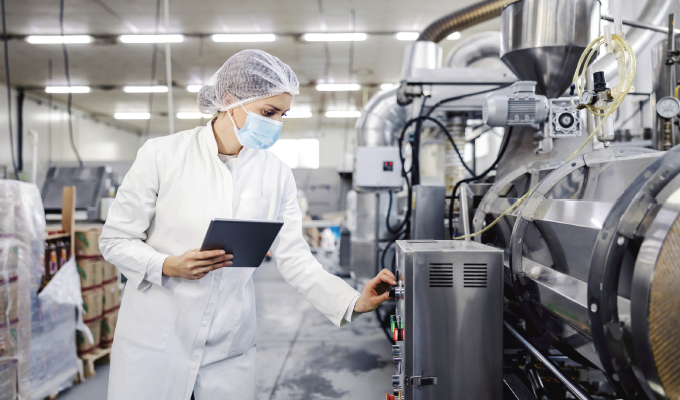When it comes to health and safety in food and drink factories, many tend focus on hygiene within production and the threat of contamination to products, as well as possible risks for consumers. However, the health and safety risks to employees working in these factories are an equally important issue.
2022 HSE statistics show a 28 percent year-on-year rise in non-fatal injuries in the workplace, with slips, trips, or falls; handling, lifting or carrying; and being struck by a moving object being the leading causes. And with more and more people now returning to factories post-Covid, the potential for the numbers to continue to rise exponentially is increasing.
Staff injuries can be particularly detrimental, and not just for the individual, slowing down operations and leading to a decrease in profits along with potential reputational damage. This means that for business owners, being aware of how to minimize the risks is invaluable.
As an engineering company, adi Projects delivers a multitude of projects within food and drink factories. The issue of employee safety is one that deserves as much attention as that of contamination within these environments.
It is a topic of utmost importance. Staff health and safety risks in factories can be overlooked for a number of reasons, and it is vital that these are correctly identified and dealt with for the benefit of employees and overall operations.
WHAT ARE THE MAIN HAZARDS WITHIN FOOD AND DRINK FACTORIES?
There are a number of hazards that are common in food and drink factories and that become difficult to manage if the factors posing a threat are not identified and properly dealt with.
Food factories are inherently full of hazards such as rotating machinery, hot and cold pipes, chemical substances, electrical lines, and much more. Humans can become exposed to chemical substances, be required to utilize tools or equipment that are not fit for use, or be subject to slips or falls from height.
There is a clear element of danger for staff working within these environments. But this doesn’t mean facility owners can become complacent: there are measures and processes that should be put into place to prevent injuries, which can be highly effective.
According to the HSE, over 30 percent of food and drink industry injuries are related to manual handling, such as back injuries, causing around 1,700 acute injuries each year. Manual labor including stacking, moving, or pushing heavy objects is one of the main causes of injury, and automation of these risky repetitive tasks such as through mechanical handling systems can be instrumental in reducing risks. Yet each individual hazard requires a tailored solution.
Of key importance is taking a responsible, holistic approach to risk management. Hazards such as slips, falls, and those stemming from workplace transport, moving objects, or machinery hazards can’t be eliminated altogether: there are certain processes within factories that can’t be eradicated yet. But this doesn’t mean that these hazards can’t be controlled to reduce risks.

DESIGNING FACTORIES WITH SAFETY IN MIND
Minimizing risks starts with factory design, and has it at its core. There are specific considerations to be taken when designing food factories to maximize safety and increase accessibility. Factors include limiting points of contact between hazards and humans, such as having hot or cold pipes in the celling void instead of anywhere near people, or ensuring rotating machinery is adequately guarded, so that risk of injury to those in the factory is minimized.
With slips and trips making up for 35 percent of major injuries in the food and drink sector, being caused by wet floors, uneven surfaces, or other obstructions, design factors become particularly important in this context. Ensuring safe access with proper facility design is equally vital when it comes to falls from height—the third most common cause of fatal injury in the industry. There is often a mentality that dictates that slips, falls, and similar accidents are common in these environments, and that there isn’t much that can be done. But this mindset can be incredibly detrimental.
When designing facilities, it’s important to give some thought to the overall infrastructure, asking questions such as how do you make the factory as dry as possible? How do you prevent contamination of walkways, or ensure there’s enough grip on the floors? Something as simple as building factories with the proper flooring or having suitable lighting inside the facility can significantly reduce certain risks.
Ultimately, it’s about alleviating all the sources of danger and reducing staff exposure to hazards. If the risks are adequately addressed at the design stage, achieving continued high levels of safety becomes easier in the long-term.
MAINTENANCE AS A PRIORITY
Manufacturers in the industry often operate from older facilities with outdated equipment, which can constitute a challenge with regards to health and safety. Regardless of whether certain safety measures were put into place at the design stage when factories were built, it is likely that unless proper maintenance has been carried out, the facility is no longer safe.
Regular health and safety assessment of the production lines and of the equipment are essential in any facility. Many forget that over time, equipment breaks down, or decide to make significant alterations without carrying out proper risk assessments.
Equipment could be perfectly safe and compliant when it’s first introduced, but that doesn’t mean it will remain safe after years of continued usage. Maintenance needs to be a continuous priority: in a live factory, things are changing all the time, which means that the reassessment of lines is vital.
There has to be an adequate awareness as to the risks brought on by a certain type of equipment, what its life span is and what investments are needed to enable this equipment to continue to be safe. And overall, it’s up to manufacturers to build this vital awareness in order to protect its staff and ensure the smooth running of operations.
FOR MORE INFORMATION
Ian Hart is business development director for adi Projects. As a director and chartered engineer, Hart has twenty-five years executive board experience, successfully establishing and developing customer focused, engineering-based business and delivering high value investments in both private and public sector organizations throughout the world. adi Projects has provided innovative solutions for a number of clients dealing with complex facility design and health and safety challenges, solving each problem at hand with a tailored, strategic approach. For more information, visit www.adiltd.co.uk/divisions/adi-projects.
MODERN PUMPING TODAY, August 2020
Did you enjoy this article?
Subscribe to the FREE Digital Edition of Modern Pumping Today Magazine!


